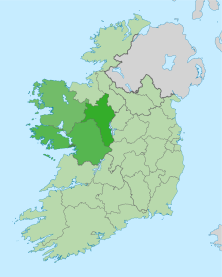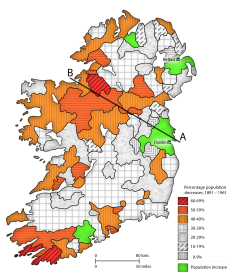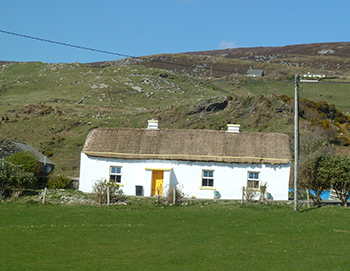👉 Find out about The Open University's Geography courses. 👈
Explore the articles in this collection
-
Change in the West of Ireland
Read now to access more details of Change in the West of IrelandIntroducing a collection of articles asking 'How can unique and distinctive regions, like the West of Ireland, retain the qualities that make them unique while continuing to modernise and interact with the wider world?'

Article
-
Synthesis as a way of understanding the changing uniqueness of rural Ireland
Take part now to access more details of Synthesis as a way of understanding the changing uniqueness of rural IrelandWhat is synthesis? Discover how this way of thinking helps us to understand more about the way in which places retain their uniqueness within wider systems of interdependence.

Activity
-
The West of Ireland: Dimensions of distinctiveness
Read now to access more details of The West of Ireland: Dimensions of distinctivenessHow do you define 'the West of Ireland'? Do you look at cultural factors, geography, or something else?

Article
-
Culture and regional distinctiveness
Read now to access more details of Culture and regional distinctivenessCulture and how language identifies that culture are key to understanding what makes a region unique.

Article
-
The rural dimension – rundale in the West of Ireland
Read now to access more details of The rural dimension – rundale in the West of IrelandThe rundale system once governed how farmland was distributed between tenants in Ireland. It supposedly died out in the 19th century, but this was not actually the case in some parts of the West of Ireland.

Article
-
The rural dimension – after rundale
Watch now to access more details of The rural dimension – after rundaleHow did the rural areas of Western Ireland change after the rundale system was replaced?

Video
-
A changing uniqueness – The changing ‘place’ of the West
Read now to access more details of A changing uniqueness – The changing ‘place’ of the WestThe population of Western Ireland declined dramatically between 1891 and 1961. How do you think this affected Ireland as a whole?

Article
-
Culture and the manufacturing industry, 1983
Watch now to access more details of Culture and the manufacturing industry, 1983In 1983, the fight to retain a unique Irish speaking culture meant that jobs had to be created locally in manufacturing and tourism so that Irish speakers no longer had to emigrate, but industrialisation also threatened the survival of the Irish language.

Video
-
The dilemma of tourism and the Irish language, 1983
Watch now to access more details of The dilemma of tourism and the Irish language, 1983Father James McDyer discusses the dilemma of the Glencolmcille holiday village between development, language and culture and the threat of depopulation. Tourism is important for economic development but what impact does it have on local culture and the Irish language?

Video
-
A new layer: Culture, the Irish language and identity in 2015
Watch now to access more details of A new layer: Culture, the Irish language and identity in 2015We revisit the Glencolmcille folk village in 2015 to see whether the dilemma of development and the local language and culture has been resolved.

Video
-
Southwest Donegal: uniqueness and interdependence in 2015
Read now to access more details of Southwest Donegal: uniqueness and interdependence in 2015In Southwest Donegal, we see both the local uniqueness and different interdependencies and interconnections with other places.

Article
-
The future of rural Ireland - nuances, scale and fighting back
Read now to access more details of The future of rural Ireland - nuances, scale and fighting backThe future of rural Ireland - nuances, scale and fighting back

Article
The period of the 1950s to 1980s was the beginning of modernisation in community life and farming and the development of manufacturing industry. Much of this was due to the work of Father James McDyer who was appointed curate to Glencolmcille in 1952. He lived and worked in the parish until shortly before his death in 1987. His pioneering work in rural community development is legendary and is a clear example of the importance of local initiative in shaping the character of an area.
You can learn more about Father McDyer on the Glencolmcille website (Glencolmcille Community website, 2013).
Transcript: Father McDyer, 1983: 'My ideal was ... a whole community family'
FATHER JAMES MCDYER: My ideal was that we would start a whole community family here, everybody working for everybody else, but I was too idealistic in that matter. But the fact remains that by the few or by the many that local cooperation is probably the only way I know how to vitalise an isolated and a low resource community such as ours.
Conditions were quite awful when I arrived here because emigration was taking a massive toll of the people, to tell you the truth. When I saw what was happening I was as mad as hell because all the young people were being siphoned off and they were just emigrating in droves, and before very long this community would die, and being saddled with an elderly population, they were thus conservative. So when the opportunity came to have electricity brought into here, rural electricity, they refused.
So one of the first things I got busy on was to rectify that and there was no pipework up to any house, and by means of what they call the group water scheme we got practically all the houses here supplied, and also I kept up a drum fire of agitation about the roads. There was only one tarmacadamed road here. So we got all the spur roads tarmacadamed and that gave the people a certain amount of confidence, but that by itself would not hold people from emigrating.
 The old family home, 2015
The realities of rural life can be seen in the experiences of a local family who were filmed in September 1983. Charles and Gladys Fuller were then living in the old family house which was built when Glencolmcille was still under ‘rundale’. Like Father McDyer, they had seen the devastating effects of the loss of especially the young people. They readily recalled the poverty and emigration of the 1940s, 1950s, and early 1960s.
The old family home, 2015
The realities of rural life can be seen in the experiences of a local family who were filmed in September 1983. Charles and Gladys Fuller were then living in the old family house which was built when Glencolmcille was still under ‘rundale’. Like Father McDyer, they had seen the devastating effects of the loss of especially the young people. They readily recalled the poverty and emigration of the 1940s, 1950s, and early 1960s.
There were considerable changes in Glencolmcille between the early 1970s and 1980s. These are expressed by Charles and Gladys Fuller, but were exemplified in their children at the time of filming in 1983. William, the elder son was farming, but his approach was commercial rather than farming for subsistence. His younger brother Norman worked in a local factory, thereby avoiding emigration, farming and the ‘dole’ (unemployment).
Charles Fuller retired from farming in the early 1980s and, in the programme, he and Gladys recalled the difficulties of making a living.
Transcript: Charles and Gladys Fuller, Glencolmcille, 1983: 'The realities of rural life'
PAT JESS: A community is often identified through settlement and housing is a major feature.
This is many people’s idea of the traditional Irish cottage, and that’s the way it features in the tourist literature. It also seems to give some people a highly romantic notion of what rural life is like. This is quite unjustified. There’s ample evidence and illustration of the sheer harshness of life which existed down into the 1950s and ‘60s, and of the very real difficulties which people like the Fullers still experience today.
Hello, are you there?
CHARLES FULLER: Aye.
GLADYS FULLER: Hello.
CHARLES FULLER: You’ve arrived.
PAT JESS: I’ve arrived indeed, yes. Oh it’s a wild day isn’t it.
CHARLES FULLER: Wicked day, same every year.
PAT JESS: Aye it is indeed. Oh it’s getting nasty now.
CHARLES FULLER: It is, yes.
PAT JESS: Great bit of heat in here.
CHARLES FULLER: Oh you need it.
GLADYS FULLER: You need it today.
PAT JESS: Sure is, it’s a lovely warm house.
GLADYS FULLER: This wall does anyhow.
PAT JESS: It’s a very old house!
CHARLES FULLER: Ah about a couple of hundred years old.
PAT JESS: Is it?
CHARLES FULLER: Yes.
PAT JESS: Is this the family home?
CHARLES FULLER: It is yeah.
PAT JESS: Have you lived in it all your life?
CHARLES FULLER: Yeah, my mother and my father always lived in it.
PAT JESS: Really.
CHARLES FULLER: Yes. Well my father was born in the States.
PAT JESS: Was he?
CHARLES FULLER: Yeah.
PAT JESS: Well what happened to your generation, people that you went to school with for example?
CHARLES FULLER: Well they all…
GLADYS FULLER: The majority all emigrated.
CHARLES FULLER: Emigrated.
PAT JESS: Where did they go?
CHARLES FULLER: Mostly all to England.
GLADYS FULLER: All practically all, England, Scotland. A few went to America, but not many.
PAT JESS: And how many would be left in the Glen now, that you would have been at school with?
CHARLES FULLER: I’d have said three or four about the height of it.
GLADYS FULLER: That’d be about all of our age.
PAT JESS: But the Fullers are leaving their old cottage. They’re now going to live in a new bungalow built very nearby by the County Council.
So you’re moving out of the old house now down to this nice new one, but why are you moving?
GLADYS FULLER: Well really this house is damp. We have no bathroom, no water inside.
PAT JESS: And what about the kitchen?
GLADYS FULLER: Well it was small and we had no accommodation for anything.
Explore the articles in this collection
-
Change in the West of Ireland
Read now to access more details of Change in the West of IrelandIntroducing a collection of articles asking 'How can unique and distinctive regions, like the West of Ireland, retain the qualities that make them unique while continuing to modernise and interact with the wider world?'

Article
-
Synthesis as a way of understanding the changing uniqueness of rural Ireland
Take part now to access more details of Synthesis as a way of understanding the changing uniqueness of rural IrelandWhat is synthesis? Discover how this way of thinking helps us to understand more about the way in which places retain their uniqueness within wider systems of interdependence.

Activity
-
The West of Ireland: Dimensions of distinctiveness
Read now to access more details of The West of Ireland: Dimensions of distinctivenessHow do you define 'the West of Ireland'? Do you look at cultural factors, geography, or something else?

Article
-
Culture and regional distinctiveness
Read now to access more details of Culture and regional distinctivenessCulture and how language identifies that culture are key to understanding what makes a region unique.

Article
-
The rural dimension – rundale in the West of Ireland
Read now to access more details of The rural dimension – rundale in the West of IrelandThe rundale system once governed how farmland was distributed between tenants in Ireland. It supposedly died out in the 19th century, but this was not actually the case in some parts of the West of Ireland.

Article
-
The rural dimension – after rundale
Watch now to access more details of The rural dimension – after rundaleHow did the rural areas of Western Ireland change after the rundale system was replaced?

Video
-
A changing uniqueness – The changing ‘place’ of the West
Read now to access more details of A changing uniqueness – The changing ‘place’ of the WestThe population of Western Ireland declined dramatically between 1891 and 1961. How do you think this affected Ireland as a whole?

Article
-
Culture and the manufacturing industry, 1983
Watch now to access more details of Culture and the manufacturing industry, 1983In 1983, the fight to retain a unique Irish speaking culture meant that jobs had to be created locally in manufacturing and tourism so that Irish speakers no longer had to emigrate, but industrialisation also threatened the survival of the Irish language.

Video
-
The dilemma of tourism and the Irish language, 1983
Watch now to access more details of The dilemma of tourism and the Irish language, 1983Father James McDyer discusses the dilemma of the Glencolmcille holiday village between development, language and culture and the threat of depopulation. Tourism is important for economic development but what impact does it have on local culture and the Irish language?

Video
-
A new layer: Culture, the Irish language and identity in 2015
Watch now to access more details of A new layer: Culture, the Irish language and identity in 2015We revisit the Glencolmcille folk village in 2015 to see whether the dilemma of development and the local language and culture has been resolved.

Video
-
Southwest Donegal: uniqueness and interdependence in 2015
Read now to access more details of Southwest Donegal: uniqueness and interdependence in 2015In Southwest Donegal, we see both the local uniqueness and different interdependencies and interconnections with other places.

Article
-
The future of rural Ireland - nuances, scale and fighting back
Read now to access more details of The future of rural Ireland - nuances, scale and fighting backThe future of rural Ireland - nuances, scale and fighting back

Article
Rate and Review
Rate this video
Review this video
Log into OpenLearn to leave reviews and join in the conversation.
Video reviews